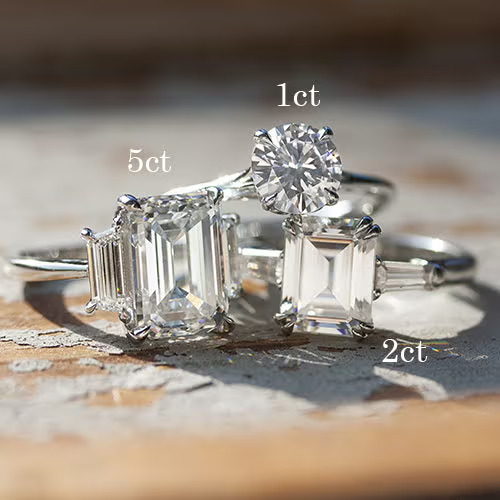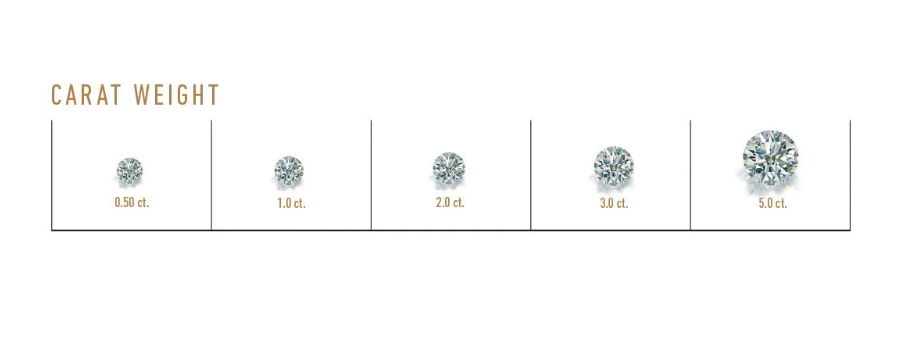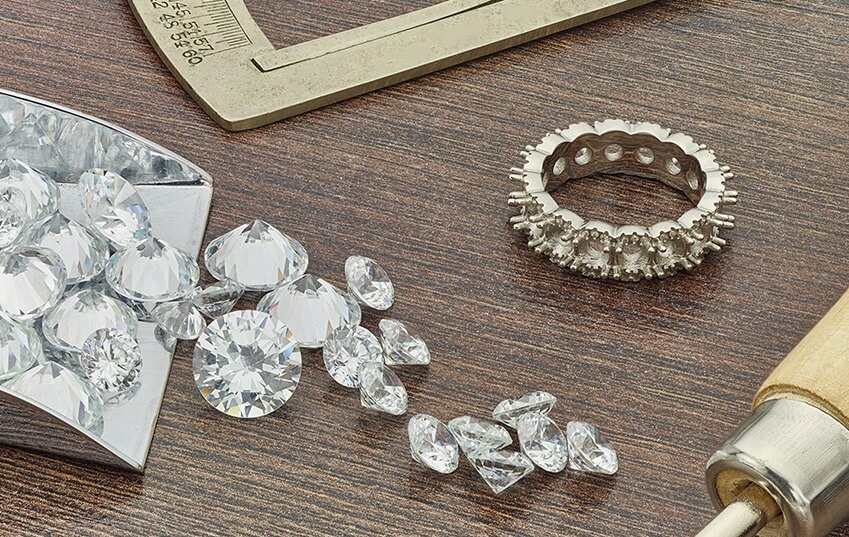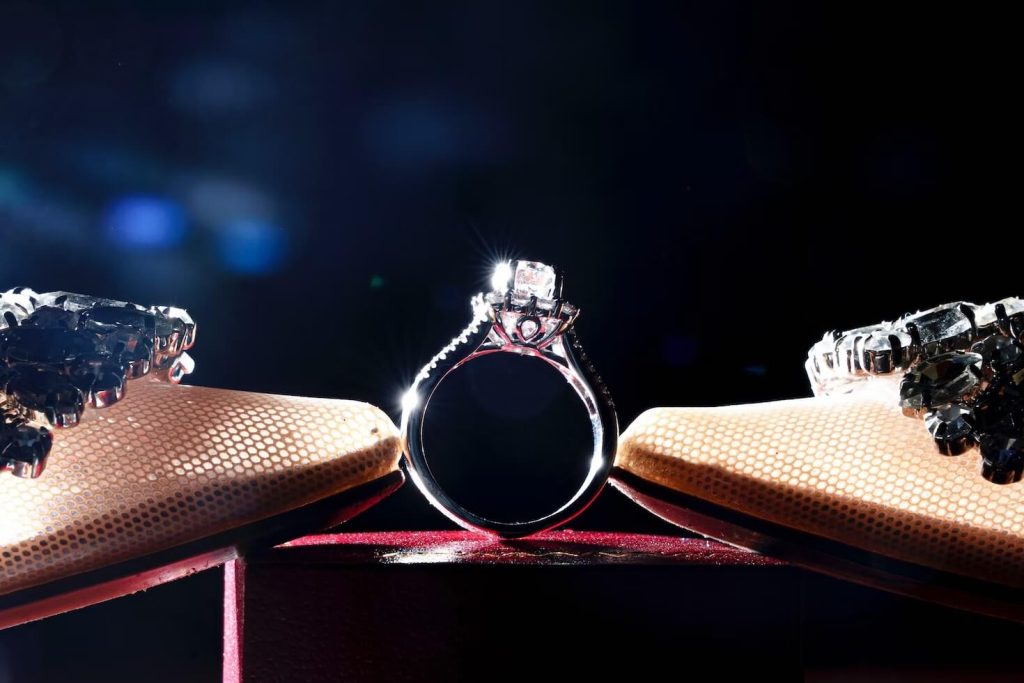
The Fascinating Connection Between Music and Diamonds: Why 5-Carat Gems Are the Showstoppers of Both Worlds
Diamonds and music may seem like two very different worlds at first glance but take a closer look and you will see how often they collide. Both are symbols of beauty aspiration and the pursuit of excellence. While music has the power to stir emotions and bring people together a dazzling diamond has the rare ability to stop time and demand attention. When you think of the word timeless chances are both a classic melody and a sparkling gemstone come to mind.
Throughout history diamonds have held a special place in our collective imagination. They have been used to mark important milestones to signal status and to express deep love. At the same time music has played a similar role as the soundtrack to our greatest moments. From grand weddings to red carpet events both a stunning diamond ring and a moving song can capture the essence of a celebration. Nowhere is this connection clearer than in the world of show business where music and luxury go hand in hand.

Some of the most memorable cultural moments have been shaped by a combination of music and diamonds. Picture the glamorous world of jazz clubs in the twentieth century where women wore bold diamond jewelry as they listened to live bands. Or think of the modern pop star flashing a five carat diamond ring on stage while a hit single plays in the background. These scenes highlight the ways in which luxury and art have always been intertwined.
In today’s world a five carat diamond is more than just a symbol of wealth. It represents achievement taste and individuality. Musicians and celebrities who choose to wear large diamonds are making a statement not just about their success but about their desire to stand out. Whether it is an engagement ring or a stage accessory the five carat diamond has become the ultimate showstopper.
The purpose of this article is to explore the fascinating relationship between music and diamonds. We will look at how both have influenced each other over the years why five carat gems are so coveted and what makes them such a powerful status symbol. From historical connections to modern celebrity culture you will discover why these two worlds are more connected than you might think.
The Allure of 5-Carat Diamonds in High Society
In high society circles the five carat diamond holds a reputation that few other gemstones can match. It is not only about the value and size but about what it represents to those who own or aspire to own one. Throughout history large diamonds have graced the hands and necks of royalty, socialites and influential figures at the very center of cultural and financial power. The five carat mark is seen as a turning point where a diamond transitions from being impressive to being truly remarkable. It becomes a conversation starter and a sign of belonging to an exclusive club.
What separates a five carat diamond from its smaller counterparts is not just its physical presence but the effect it has on those around it. When someone enters a room wearing a diamond of this size there is a natural shift in attention. Conversations pause for a second and eyes are drawn to the unmistakable sparkle. In many ways the five carat diamond acts as an introduction before the wearer ever says a word. It carries an air of confidence and success that cannot be easily replicated with smaller stones or other forms of jewelry.
Beyond its ability to attract attention the five carat diamond has long been used as a signal of achievement. For many in elite circles such a diamond is purchased to commemorate major milestones. These could include career breakthroughs family legacies or other significant accomplishments. The diamond is not simply a piece of jewelry but a symbol of the hard work and perseverance that led to its acquisition. It serves as a quiet yet undeniable reminder of personal or familial triumphs.

High society events offer the perfect stage for five carat diamonds to shine. Gala evenings charity balls and exclusive dinner parties provide a backdrop where luxury is not only expected but celebrated. At these gatherings it is not uncommon to see several attendees sporting five carat gems set in unique and custom-designed rings necklaces or earrings. Each stone often has its own story sometimes passed down through generations or acquired through unforgettable moments. The diamonds themselves seem to absorb the stories of the events they witness.
The allure of a five carat diamond extends beyond the moment of purchase or the evening it is worn. These stones become a legacy often intended to be handed down as family heirlooms. The emotional value they carry grows with each new generation that inherits them. A five carat diamond ring or necklace can become the centerpiece of family stories inspiring awe and admiration in those who see it. In this way high society’s fascination with these gems is about far more than appearance.
To truly understand why five carat diamonds captivate high society you must consider the blend of rarity and perfection they embody. Large gem-quality diamonds are much harder to find in nature and require exceptional skill to cut and polish. Their price is not just a reflection of size but of the almost impossible odds of their existence. For many this adds an extra layer of pride and wonder to their ownership. The allure is about joining a very small group of people who possess something nearly unattainable.
The stories of five carat diamonds in high society are often wrapped in glamour intrigue and sometimes even mystery. Auction houses around the world have seen fierce bidding wars over famous stones with collectors eager to claim their place in history. The fascination is not limited to those who can afford such luxuries. Even for outsiders the idea of owning or simply seeing a five carat diamond up close is thrilling. It reminds us that some symbols of success and beauty never lose their power to inspire.
How Diamonds Have Inspired Music Through the Ages
Diamonds have captivated artists for centuries and musicians are no exception. The image of a diamond has appeared in songs, symphonies, and even the names of bands and albums. These sparkling gems have served as metaphors for love, resilience, and aspiration. When a songwriter is searching for a word that signals strength and brilliance few choices are as instantly recognizable as “diamond.” Across generations musicians have drawn on the mystique and luxury of diamonds to enhance their work.

In early popular music diamonds were already powerful symbols of romance and longing. Songs from the first half of the twentieth century often referenced diamonds as proof of enduring love or tokens exchanged during courtship. The phrase “diamond ring” quickly became shorthand for marriage proposals and lifelong commitment. Even before the days of modern marketing diamonds had already embedded themselves deeply in the language of love songs and ballads. In this era music and diamonds together shaped people’s perceptions of romance and elegance.
The influence of diamonds on music only grew stronger as popular culture evolved. By the time jazz and swing took center stage in glamorous nightclubs diamonds were not just accessories but stars in their own right. Legendary performers like Billie Holiday and Ella Fitzgerald sang under stage lights that reflected off their diamond earrings and necklaces. The connection between a dazzling performance and a dazzling gemstone was clear. Musicians and their audiences both came to associate luxury jewelry with artistic excellence.
Rock and roll brought an edgier but no less passionate relationship with diamonds. Icons such as Elvis Presley and The Rolling Stones used diamond imagery to evoke fame, fortune and the wild ups and downs of stardom. In these genres diamonds were sometimes portrayed as spoils of success and sometimes as burdens. A diamond ring could be a trophy or a chain. Musicians explored both the light and shadow that comes with luxury turning the gem into a powerful symbol for all kinds of human experience.
Hip hop and contemporary pop have continued this tradition but with their own unique twist. In these genres diamonds often stand for more than just wealth or status. They are about self-expression, survival, and making it against the odds. Rappers have immortalized diamonds in their lyrics using them to represent both the rewards and the costs of success. “Diamonds from Sierra Leone” by Kanye West for example explores the complexities behind the glitter while Rihanna’s “Diamonds” invites listeners to shine bright regardless of where they started. Here the diamond becomes both an accessory and a message.
Classical and instrumental music have also embraced the allure of diamonds in more subtle ways. Composers have written pieces inspired by the clarity brilliance and perfection that diamonds suggest. Whether it is a sparkling piano melody or a shimmering orchestral passage the influence is often felt in the texture and mood of the music itself. The pursuit of perfection in a diamond is mirrored in the musician’s quest for flawless technique and unforgettable sound. This parallel between two art forms is part of what keeps the relationship so enduring.
Throughout all these changes one thing remains constant: the diamond’s ability to inspire creativity. Musicians see in diamonds a kind of hope and possibility that translates naturally into song. Whether it is the promise of forever the dream of making it big or the bittersweet cost of ambition diamonds capture the imagination in ways few other symbols can. This is why music and diamonds remain bound together in a dance of aspiration and artistry.
Famous Songs That Name-Drop Diamonds
Some of the most memorable songs across decades are those that mention diamonds directly in their lyrics or even in their titles. This lasting connection between diamonds and popular music has helped shape our perception of both. When artists name-drop diamonds it is often to signal luxury, longing, or a life that sparkles above the ordinary. In many cases the diamond becomes a character in the story a song is telling, taking on meaning beyond just wealth or beauty. Fans remember these lines and choruses long after the song fades from the charts.

One of the earliest and most iconic examples is “Diamonds Are a Girl’s Best Friend,” first performed by Carol Channing and later immortalized by Marilyn Monroe in the film Gentlemen Prefer Blondes. This song set the standard for how diamonds could symbolize romance, desire, and the pursuit of happiness. Monroe’s performance in her pink dress surrounded by men offering sparkling jewels has become a pop culture touchstone. The song’s message is playful yet direct: diamonds endure even as love comes and goes. It continues to inspire covers and references more than seventy years after it first appeared.
The Beatles added their own shimmering contribution with “Lucy in the Sky with Diamonds.” While the song’s title has sparked countless debates about its meaning its connection to dazzling imagery is unmistakable. With lyrics that transport listeners to surreal landscapes where the sky itself is studded with diamonds the song uses the gem as a metaphor for wonder and imagination. Whether the diamonds in question are literal or symbolic the song has become a classic example of how music can make an ordinary object seem extraordinary.
Modern artists have kept the tradition alive by making diamonds a central part of their hits. Rihanna’s “Diamonds” is a global anthem that encourages listeners to “shine bright like a diamond.” The song celebrates resilience inner strength and the ability to rise above challenges. It is not just about luxury but about shining from within. The track’s hypnotic melody and uplifting message have made it one of Rihanna’s signature songs, played at celebrations and on playlists around the world.
Kanye West’s “Diamonds from Sierra Leone” takes a different approach using the symbol of the diamond to raise questions about ethics and responsibility. In this song West explores the origins of the gems and the conflicts that sometimes surround them. The lyrics and the haunting sample of Shirley Bassey’s “Diamonds Are Forever” make the track both catchy and thought-provoking. By linking diamonds to real-world issues the song shows how a luxury item can also be the starting point for deeper reflection.
Other notable examples include Pink Floyd’s “Shine On You Crazy Diamond” which turns the gem into a tribute to lost friends and artistic brilliance. Neil Diamond whose very name is a nod to the stone built an entire career with his sparkling persona and memorable ballads. From Queen’s “Lily of the Valley” with its reference to diamonds in the lyrics to Madonna’s “Material Girl” that echoes the glamour of Monroe’s diamond anthem the list is long and varied. Each song adds a new layer to the story of diamonds in music.
The consistent presence of diamonds in hit songs is a testament to their enduring appeal. Whether used to evoke glamour, question morality, or inspire courage the diamond remains a symbol musicians return to again and again. These songs help keep the fascination alive for new generations ensuring that the sparkle of a diamond is never far from the center of pop culture.
Why Musicians Love to Flaunt Big Diamonds
In the world of music image and presence matter almost as much as talent. For many musicians the choice to wear large diamonds is not just about owning a beautiful accessory. It is a deliberate way to project confidence status and individuality. The stage is a place where first impressions are everything and nothing catches the light or the audience’s eye, like a five carat diamond ring, or a dazzling necklace. Musicians understand that these gems help to create an aura of luxury that lingers long after the final note.
The appeal of flaunting big diamonds often goes beyond simple vanity. For artists who have risen from humble beginnings these stones represent a tangible proof of how far they have come. A diamond’s journey from rough stone to polished perfection mirrors the musician’s own path to success. When a performer walks out under the spotlight adorned in showstopping jewelry they are telling a silent story of struggle triumph and self-made accomplishment. Every sparkle is a reminder of the hard work and sacrifice that made such rewards possible.

Big diamonds also serve as a form of artistic expression. Musicians are natural storytellers who use every tool at their disposal to captivate their audience. The right diamond ring or custom-designed pendant can become a signature look as recognizable as a unique hairstyle or a catchphrase. Over time these jewelry choices get woven into the artist’s brand making them instantly identifiable. Think of Elvis Presley’s flashy rings or Beyoncé’s iconic stage jewelry, these pieces are as much a part of their persona as their music.
The competitive nature of the music industry is another reason why musicians love to showcase impressive diamonds. On red carpets at award shows and in music videos artists are constantly vying for attention and headlines. Sporting a rare or oversized diamond can set a musician apart from their peers and spark conversations among fans and media alike. Luxury jewelry becomes a statement piece that signals not just taste but also relevance in a world where visibility is key to career longevity.
There is also a social aspect to wearing big diamonds in the music world. These gems often serve as gifts to mark major career milestones such as platinum records sold-out tours or important collaborations. They are given by managers, family members, or even fans and carry sentimental value that goes far beyond price. Some musicians even commission bespoke jewelry pieces that feature personal motifs or hidden messages. Each diamond becomes a chapter in the artist’s story and a way to keep memories close even in the midst of fame’s whirlwind.
Finally, the tradition of flaunting big diamonds speaks to a deeper human need for celebration and recognition. Musicians spend years honing their craft often facing rejection and uncertainty along the way. When success comes it is natural to want to mark the achievement in a way that feels permanent and meaningful. A five carat diamond does not just symbolize financial reward, it embodies pride, joy and the sense of having reached a place in life where dreams really do come true.
The relationship between musicians and their diamonds is therefore about much more than glamour. It is about identity, resilience, and the unspoken messages that these remarkable gems can send to the world. In every genre and at every level of fame, musicians have found that a big diamond is more than just an accessory, it is a powerful tool for telling their story.
Diane Moser’s Expert Take: What Makes a 5-Carat Diamond So Special?
As a seasoned gemologist Diane Moser has spent years examining diamonds of every size color and clarity. Still she admits there is something uniquely captivating about a five carat diamond. To her these stones are not just larger versions of their smaller counterparts. They embody a rare intersection of science, artistry and human emotion. Diane believes that a five carat diamond represents the moment when a gemstone transcends simple decoration and becomes an enduring symbol of personal achievement and legacy.
According to Diane the magic of a five carat diamond starts with its sheer rarity. Finding rough material large enough to cut such a gem is a rare occurrence in nature. Each five carat diamond is the product of both geological luck and expert human craftsmanship. Diane often describes the process as a delicate balancing act between preserving as much weight as possible and achieving the perfect balance of proportions, symmetry and light performance. Every decision made during cutting can mean the difference between an ordinary stone and one that commands attention.
What sets a five carat diamond apart for Diane is also the level of detail required in its grading and evaluation. At this size even the slightest inclusion or flaw becomes more noticeable. Diane points out that a five carat stone must not only have visual appeal but must also meet strict standards for clarity and color. She emphasizes that these gems reveal both the strengths and weaknesses of their origin. This transparency can be intimidating but it also makes the final result even more impressive when everything comes together in harmony.
Diane often notes the psychological impact that a five carat diamond can have on its owner. She observes that people who select a diamond of this size are often drawn to its ability to evoke strong emotions and create lasting memories. Whether the stone is set in an engagement ring, a pendant, or a family heirloom, it becomes an anchor for important life moments. Diane has witnessed many clients who see their five carat diamond as a milestone, marking a turning point in their journey or celebrating a personal victory.
The journey of a five carat diamond from mine to masterpiece is a testament to patience and vision. Diane describes how each stone has its own story, shaped by the forces of nature and the skill of master cutters. This story is then woven into the lives of those who own and wear the diamond. For Diane a five carat gem is not simply an object of desire. It is a living narrative, passed from hand to hand, and admired by all who come into its orbit.
Diane’s perspective highlights that the significance of a five carat diamond cannot be reduced to price alone. It is about rarity, beauty, and the sense of possibility that such a gem inspires. In her view these stones continue to fascinate because they speak to something universal-the desire to possess and protect something extraordinary. For Diane and for many who trust her expertise a five carat diamond is more than a showpiece. It is a reflection of ambition love and the timeless power of nature transformed by human hands.
Final Thoughts: Are Diamonds a Musician’s Best Friend?
As we reach the end of this exploration it is clear that diamonds and music share more than a passing connection. Both have the power to stir emotion to mark life’s greatest moments and to inspire admiration from those who witness their brilliance. The five carat diamond in particular has emerged as a symbol that musicians and music lovers alike find irresistible. Whether shining from a stage or featured in a timeless lyric it captures attention and leaves a lasting impression. The question remains though: are diamonds truly a musician’s best friend?
For many musicians diamonds represent more than just material wealth. These gems become milestones reminders of long journeys and the rewards that come after years of dedication. The moment a musician slips on a five carat ring or necklace is often the culmination of countless hours spent perfecting their craft and overcoming obstacles. In this way the diamond is not just an accessory but a trophy, a tangible sign of personal and professional growth. When fans see their favorite artists wearing such jewels they are witnessing the celebration of achievement and the sparkle of hard-won dreams.
Diamonds also have a way of weaving themselves into the fabric of music culture. From jazz clubs of the past to the world’s largest arenas today these stones are never far from the spotlight. Their allure lies in their duality. On one hand they are deeply personal, representing family history or a special moment in time. On the other they are outward signs of success visible to everyone who follows an artist’s journey. Musicians have used this duality to their advantage shaping public perception while cherishing private meaning.
But perhaps what cements the bond between musicians and diamonds is the shared quest for something that lasts. Just as a hit song can echo through generations a well-chosen diamond can endure beyond a lifetime. Both are crafted with care both are meant to be remembered and both have a way of speaking to the heart. For some musicians this parallel is reason enough to see diamonds as more than just beautiful stones. They become companions on the path of life shining brightest when the spotlight is on.
In the end whether diamonds are truly a musician’s best friend depends on what you value most. Some see only luxury and status while others recognize the deeper stories that each gem holds. For those who appreciate both music and fine jewelry the answer might be simple. A diamond’s sparkle and a song’s melody are both timeless and when they come together they create moments that neither art form could achieve alone.
Diamonds have inspired countless songs and shaped the image of musicians in ways that continue to evolve. As new generations of artists take the stage and share their stories it is certain that the relationship between music and diamonds will only grow stronger. The five carat diamond will remain a symbol not only of success but also of the artistry and ambition that drive musicians to chase their brightest dreams.…





